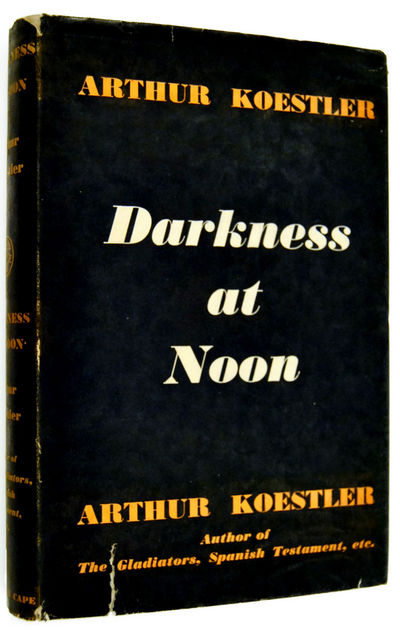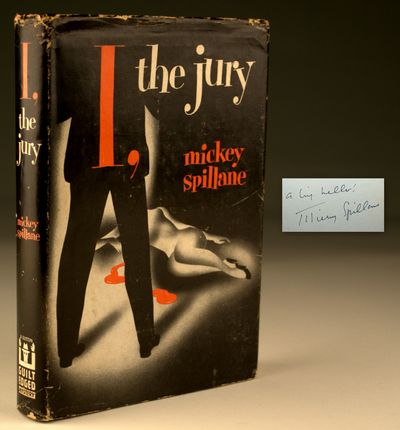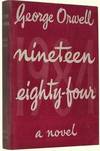Modern First Editions 1940-1949
-
For Whom the Bell Tolls by Ernest Hemingway
Many consider For Whom the Bell Tolls to be author Ernest Hemingway's finest work. Inspired by Hemingway's time as a war correspondent for The North American Newspaper Alliance during the Spanish Civil War, For Whom the Bell Tolls is a stark and brutal commentary on the nature of war, sacrifice, and death. In fact, many believe his work is among the best depictions of the Spanish Civil War written. As with some of Hemingway's other work, many of the characters, experiences, and events were based off real people and battles Hemingway saw.One of the most interesting qualities of For Whom the Bell Tolls is the use and restraint of profanity. Even though Hemingway had already written much about war and tribulations and had never seemed inclined to limit the use of vulgar language, For Whom the Bell Tolls is a clear exemption. When writing dialogue, Hemingway would insert the word 'obscenity' instead of writing the exact word or phrase. There has been a lot of discussion about the reason for such omissions, and while some believe Hemingway was worried about the book being banned and thus wanted to make the book as reader-friendly as possible for a brutally violent war novel, others believe the omissions of profanity was due to transliteration problems and the author's attempt to be as honest to the dialogue he heard as possible.There is no arguing with the legacy and influence Hemingway had not only on American culture, but also on generations of future writers. Hemingway inspired countless journalists with his in-depth profiles and wartime articles. Even the cities where he wrote his books are now places for pilgrimage among his most devoted fans. Hemingway first started writing For Whom the Bell Tolls in Cuba and later finished it in Sun Valley, Idaho. In fact, both hotel rooms are now popular tourist destinations.
-
Native Son by Richard Wright
Native Son, as the first book by an African American author to be featured on the extremely popular Book of the Month Club, had a deep and wide-reaching impact on American culture. Published in 1940, a volatile time in American history, Native Son was a harsh indictment on the state of Black men and the small box into which society had placed them. In writing Native Son, author Richard Wright was remarking on the seeming inevitability of crime that awaited so many Black men. While never apologizing or forgiving the protagonist's crimes, many believe that Native Son argued that the main character, Bigger, never had much of a choice but to live a destitute, criminal life. Unsurprisingly, Native Son was the subject of much controversy when it was first published. The brutal violence, graphic sex, and profane language lead many to try and ban the work, and some Black Americans were unhappy with the depiction of the Black characters. Even the act of printing the first public edition of Native Son was not without controversy. While the publisher, Harper and Brothers, were willing to publish Wright's original manuscript, the Book of the Month Club demanded that a few passages be edited or removed for their graphic content. Luckily, the Library of America published a complete and unedited version of Native Son in 1991 for public release, complete with an introduction and notes by prominent African American literary historians. Many have called Native Son one of the best and most influential works of African American literature. Not only was its theme of racial strife and inequality important, but Native Son also represents an important piece of Naturalist literature. In fact, some academics have called Wright one of the fathers of the Naturalist movement. Naturalism dictates that people are shaped primarily by their experiences and circumstances, and they are often bound to certain life trajectories, regardless of their intent. With the seeming inevitability of Bigger's tragic existence, Native Son certainly holds true to the Naturalist philosophy.- Shop first editions of Native Son
- Shop signed first editions of Native Son
- Shop all copies of Native Son
Of Note for This Year:
1940 also saw the last publication of one of the most popular novelists of the late 19th and early 20th century, and the bane of many a budding book collector.
Winston Churchill was the author of 12 novels revolving around romance and history. Winston Churchill the novelist was not the same as the famous British statesman Winston S. Churchill. The two contemporaries realized at one point that their shared name would create confusion in the public, so they agreed that one of them should take a middle initial to help differentiate them from each other. It was agreed that the politician should use his middle initial since he was the less known of the two.
History has almost entirely forgotten Winston Churchill, the novelist, but people still come upon his works from time to time gathering dust in the fiction shelves of used bookshops and believe for a moment that they may have scored an early, rare work by a future Prime Minster. -
Darkness at Noon by Arthur Koestler
A disclaimer: The staff at Biblio spent a good deal of time debating over whether or not to include Darkness at Noon into this list, as it technically breaks our guidelines not once, but twice! When we were first discussing how to choose the best modern firsts published each year, we stipulated that the book had to be published in English and it had to be first published in the year in question. However, not only was Darkness at Noon first published in German, it was also first published in 1940. The first edition published in English was in 1941. Unfortunately, we had a lot of trouble finding a suitable book published in 1941 that met all of our requirements. We debated back and forth about whether to include a submission at all for 1941, but in the end, we decided to bend the rules and include Darkness at Noon. Darkness at Noon has remained one of the greatest published novels about the Soviet era. Its disturbing plot, captivating dialogue, and enduring tone of sorrow and fatality makes it a difficult yet important book to read. The plot focuses on the incarceration of its protagonist by the communist government, and while it never says explicitly that the dictator is Stalin, the book is overwhelmingly considered anti-Stalinist. Published during a time of great international turmoil, Darkness at Noon introduced the world to realities it was not yet prepared to face. -
Go Down Moses and Other Stories by William Faulkner
The inclusion of Go Down, Moses on our list of the most influential modern first editions may be controversial. Some argue that Go Down, Moses should not be considered a traditional novel, but William Faulkner was never a traditional writer. Go Down, Moses is a collection of seven short stories that spans over a hundred years of the history of a Mississippi family. Though fragmented, Faulkner himself argued that Go Down, Moses is a novel, and may have even argued that the title should have only been Go Down, Moses and not include the phrase, 'and other stories'.Like so many others of Faulkner's writings, Go Down, Moses focuses on the trials and tribulations of a single family, and it is an important work in the Southern Gothic genre. Faulkner uses his typical stream of consciousness and internal monologues in Go Down, Moses, and places particular emphasis on the African American characters. Faulkner was one of the few White writers of the time to write African American characters with insight and depth, and he uses Go Down, Moses as a way to tackle many of the racial stereotypes and difficulties that plagued both White and Black Americans of the time.Go Down, Moses is not the most famous of Faulkner's work, and it is a challenging and sometimes inaccessible reading experience. Typical of Faulkner, the character family tree in Go Down, Moses is complex and often confusing, forcing the reader to read slowly and piece together the inter-connectedness of the various characters. But Go Down, Moses represents an important trend in American literature of the 1940's. A time of great racial and social strife, many writers were exploring themes of nature, family, and our obligations to one another--themes that are directly addressed with subtlety and grace in Go Down, Moses.
-
The Screwtape Letters by C.S. Lewis
C.S. Lewis is without a doubt one of the most influential and admired authors of the 20th century, and his 1942 work The Screwtape Letters is responsible for making him a household name. One of the most well-known of the Christian apologist novels, The Screwtape Letters is a collection of letters from Screwtape, a retired but formerly high ranking demon and his up-and-coming demon of a nephew, Wormwood. In the letters, Screwtape is advising Wormwood on how best to manipulate and plague his 'patient', a young man who recently converted to Christianity. The book is entirely written solely of these letters, so the reader develops a deep understanding and intimacy with Screwtape.The Screwtape Letters was an instant success, even more so after Lewis gave a series of interviews on the BBC radio. The Screwtape Letters was adapted into radio plays, stage productions, and the film rights were bought in the 1950's. Further, even though the fame of The Screwtape Letters pales in comparison to The Chronicles of Narnia, Screwtape continues to have a strong cultural presence in the Western world.Even though many readers pay little attention to the dedications the authors include at the beginning of novels, the dedication of The Screwtape Letters is particularly interesting and reveal quite a bit about both Lewis and his work. Lewis dedicated The Screwtape Letters to his friend, colleague, and literary rival, author J.R.R. Tolkein. Even though there is quite a bit of debate as to how much Lewis and Tolkein actually liked the other's work, the influence felt by each is undeniable. In fact, Tolkein is given credit for converting Lewis to Christianity, the faith that of course inspired much of Lewis' work. When Lewis was first beginning to write Screwtape, Tolkein warned Lewis not to dwell to long or to deeply in the mind of demons, as they only lead to darkness. Lewis would later remark that he never truly enjoyed writing Screwtape, for it brought him too close to the thoughts of demons and of the nature of evil.Ultimately, even though Screwtape never enjoyed the same level of popularity as Lewis' later work, the influence and impact of Screwtape on the future work of Lewis is incalculable. Lewis will forever be remembered as one of the foremost writers on Christian thought, and Screwtape will be remembered as a masterful piece of Christian literature.
-
The Fountainhead by Ayn Rand
Though Ayn Rand may be best known for her later novel Atlas Shrugged, many call her 1943 work The Fountainhead to be her crowning achievement. The Fountainhead's plot follows the life of protagonist Howard Roark, a brilliant yet stubborn architect who eschews the industry's fixation on traditional architecture. Roark strongly believes in his modernist designs, but he continually has to fight the forces that be that try to derail and diminish his vision. While politics were never far from Rand's writing, she considered The Fountainhead to be apolitical, instead insisting that the novel focuses on the personal battles her characters must fight in the face of bureaucracy and mediocrity.
As with her earlier novel We the Living, it took Rand a long time to find a publisher willing to publish such a large and intellectual book. After being rejected by no less than 12 publishers, The Fountainhead finally found a publisher with Bobbs-Merrill Company. Even though the book was met with middling reviews and not a lot of publicity, The Fountainhead's audience grew by word of mouth and became a best seller in just two years.
Rand's politics are well known, and they have been incredibly influential. There was never much ambiguity in her writing when it came to her beliefs, and she is considered one of the leading pioneers in modern American Libertarianism. Rand was adamant about her ideas of the 'ideal man', and had no shame in building a pedestal upon which he could stand.
When considering great works of literature published in the 1930's and 1940's, it is always intriguing to compare and contrast the politics and philosophies of authors on opposite ends of the spectrum, such as John Steinbeck and Ayn Rand. To dig even deeper, it is always important to remember the international backdrop in which these authors produced their most important works, which in the case of Ayn Rand, was the rise of fascism and World War Two.
-
The Razor's Edge by W. Somerset Maugham
Considering the Eastern mysticism and philosophy combined with the depiction of physical and spiritual war fatigue experienced by the protagonist, Somerset Maugham's 1944 work The Razor's Edge had a strong impact on the world when it was published. The elegance and emotion depicted in the novel resonated with many readers, and the philosophical and spiritual crisis felt by the main character, Larry Darrell, were quite relatable. Since Maugham had a prior history of writing fiction strongly based off his personal experiences, many wondered if Maugham lived through the events he writes about in The Razor's Edge. There continues to be thoughtful debate over the possible real-life candidates who may have inspired the character of Darrell, but there hasn't yet been any significant consensus. In the novel, Darrell has undergone a significant period of turmoil caused by his experiences in the First World War. In an effort to find meaning again in the world, Darrell leaves everything behind and begins exploring the world, particularly India. The emphasis on Eastern philosophy set The Razor's Edge apart from many of its contemporaries novels, and readers were greatly intrigued by Darrell's travels and immersion into Indian life and culture. Considering how exhausted the Western world was from decades of war and economic turmoil, the escape into a foreign land must have been quite welcome. The focus on mysticism set Maugham about a decade ahead of his time, for it would not be until a decade later when the Beat Generation would begin looking closely at Eastern thought again -
Brideshead Revisited by Evelyn Waugh
One thing can be certain: You either love Brideshead Revisited, or you hate Brideshead Revisited. Evelyn Waugh's opus about English aristocracy in the 1920's and 1930's was controversial when it was first published in 1945, and it still remains the topic of great debate today. While many of the books of that era were controversial because of language or sexual content, but Brideshead Revisited is controversial because of how it deals with religion and class. The topic of Roman Catholicism played heavily in the book, and many debate over whether the book serves as a condemnation or apology for the religion. With the exception of the protagonist, most of the main characters of Brideshead Revisited are devout in their Catholicism, and the religion offers them both soul-crushing guilt and profound peace and serenity. Further, the romantic description of the English aristocracy also irked many of the British people who were focused on the very modern problems of the 20th century, namely World War Two. The problems and personal dramas of the wealthy simply did not sit well with some readers, and they were not interested in participating in the nostalgia for English nobility. Despite the criticisms however, Brideshead Revisited was also met with wider popular appeal, as some were eager for a literary escape from the horrors of modern life. Waugh was already an accomplished author by the time Brideshead Revisited was published, and the New York Times called the novel "Mr. Waugh's finest achievement." Even though Waugh was immensely proud of his work when it was published, he would later go on to lament that Brideshead Revisited was "...infused with a kind of gluttony, for food and wine, for the splendours of the recent past..." that did not age well with time. In the end, it seems like Brideshead Revisited was written with purpose to be a kind of vacation, not one that everyone was interested in taking. -
All the King's Men by Robert Penn Warren
All the King's Men is a dark and often lonely novel with a nice bit of nihilism thrown in there for added flavor. The book would go on to win the Pulitzer Prize for fiction in 1946 and would be adapted into an Academy Award winning film in 1949. The New York Times first said the novel '...is no book to curl up with in a hammock, but a book to read until 3 o'clock in the morning, a book to read on trains and subways, while waiting for street cars and appointments, while riding elevators of elephants'. Simply put, the cultural impact of All the King's Men cannot be overstated. With a plot focusing on the emotionally charged and politically corrupt nature of Southern politics, All the King's Men considers the difficult themes of destiny, death, and courage in the face of an uncontrolled and unchangeable fate. For Americans facing the threat of growing global fascism and a seemingly endless war, All the King's Men certainly seemed to appeal to a large audience. Readers were captivated with the characters and the gripping dialogue, and the plot twists made the book surprising up until the last page. The adapted film was just as captivating, and it expanded the novel's influence even further. Perhaps one of the most compelling and influential aspects of All the King's Men was the feeling of inevitability that the characters experience. Their seeming lack of control over their destinies allowed them to engage in shameful behavior, much of it vilely corrupt. Even though the novel ends on a somewhat more optimistic note, this feeling of nihilism would go on to influence many more authors through the years. Considering the time in which All the King's Men was introduced to the world, it is no wonder why the book had such a profound impact -
I, the Jury by Mickey Spillane
Written in fewer than three weeks, I, The Jury influenced American literature for decades. Written to offset the costs of a country retreat for him and his wife, writer Mickey Spillane was always sure of the success his hardboiled detective story would enjoy, and he was not mistaken. Despite early negative reviews by well-known and respected literature critics, I, The Jury would go on to sell more than six million copies in the United States. Heavy with sex, violence, and rough language, I, The Jury was not like many of the other more sophisticated novels of its era, but that is perhaps what appealed to so many people. In an interview with Strand Magazine, Spillane would later explain that he wrote I, The Jury specifically for the burgeoning paperback originals instead of the more formal hardcover tradition. Spillane took little notice of the negative critical reviews, because he believed that only good books would become popular, and his book was undeniably popular. I, The Jury continued the long tradition of the hardboiled detective genre, and like many books of the genre, it also contained the elusive, captivating, and cruel femme fatale. Further, like many of the hardboiled detective novels, I, The Jury also introduced the world to the iconic detective, Mike Hammer. In a decade filled to the brim with high-brow literature, there is no denying the appeal of a 'lower-brow' book like I, The Jury. -
The Naked and the Dead by Norman Mailer
Norman Mailer is one of the most influential and iconic writers of the 21st Century, and his first novel, The Naked and the Dead, set the stage for his illustrious career. Written in just a few weeks, The Naked and the Dead is a gripping war novel exploring the themes of death, brotherhood, loneliness, and violence. Set against the backdrop of the war in the Philippines, Mailer uses a variety of literary techniques to illustrates the horrors of war, including a strong journalistic-style narrative. The novel catapulted Mailer's career and he quickly became a household name, not just for his fiction, but for his burgeoning career as a nonfiction investigative journalist. Many consider The Naked and the Dead to be one of the best war novels of the modern era, and Mailer was confident in its quality as well. The striking brutality and cruelty of battle, as well as the vital and tender relationships between the men that fight them is well explored in the book, as well as the deep psychological wounds that are inflicted on the soldiers. For a nation embroiled in another foreign war, The Naked and the Dead had a monumental impact on readers. -
Nineteen Eighty-Four by George Orwell
Of all the tremendous modern first editions published in the 1940's, Nineteen Eighty-Four has had the most profound effect on culture and politics. The well-known plot and characters of the book continue to inspire fear and mistrust of governmental officials, and it's hardly a day that goes by without someone remarking on the "Orwellian" nature of our modern lives. Nineteen Eighty-Four was author George Orwell's last published work, but it had by far the greatest impact. Written just a few years after his previous book Animal Farm, Nineteen Eighty-Four was a scathing critique of Joseph Stalin's totalitarian government. The erasure of history, the "vaporization" of history, and the near total manipulation of the public were only some of the characteristics of Orwell's fictional world, and they certainly kept the readers' attention. Perhaps the most commonly referenced part of Nineteen Eighty-Four is the total and complete authority of the surveillance state. The all-seeing eye of Big Brother terrorized the citizens in the novel, and it terrified readers as well. As technology becomes more efficient and more present in our daily lives, and as governments use those technologies to maintain order and civility, the presence of surveillance systems will only become more mainstream, making Nineteen Eighty-Four ever more relevant in our lives.
Subscribe
Sign up for our newsletter and receive coupons via email.

Author Bio: Amy C. Manikowski is a writer, bookseller, trail-diverger, history buff, and pitbull lover. She graduated from Chatham University with an MFA a while ago, and after wandering aimlessly settled in Asheville NC.












